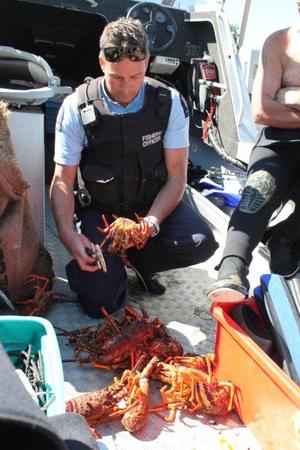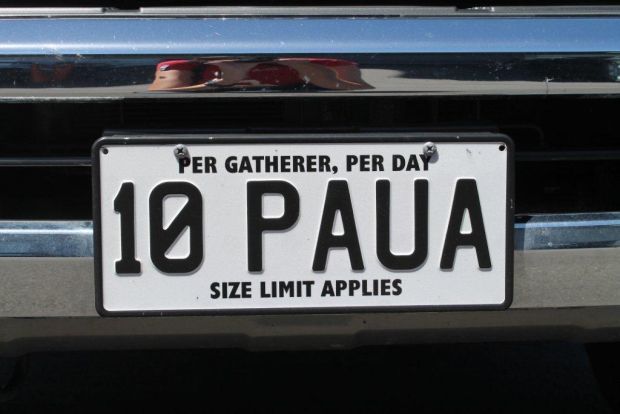
The coastline around Wellington is the "black gold" smuggling capital of the Southern hemisphere. It's not so much for the finfish but the rock lobster (crayfish) and shellfish; in this case - paua. Paua is the Maori name given to the species of blackfoot abalone that normally grows in abundance around the coasts of Wellington.
Paua is nicknamed "black gold" because it fetches such high prices on the black market, especially among the hundreds of Asian restaurants and takeaways in Auckland region. Wellington has a rocky and rich marine environment, perfect for spawning paua and crayfish, but not when the resource is pillaged to the point of depletion.
 It's in the middle of the day at the Petone offices of the Fisheries branch of the Ministry of Primary Industries, Manatū Ahu Matua. In a darkened room around 10 Fisheries Compliance Officers have gathered to be briefed on Operation Pikirere. It's a concerted bust targeting PBM or "poaching black market", timed at peak season just before Chinese New Year. It's Compliance Officer Shay Lalich's first time to head an operation as the newest member of the team.
It's in the middle of the day at the Petone offices of the Fisheries branch of the Ministry of Primary Industries, Manatū Ahu Matua. In a darkened room around 10 Fisheries Compliance Officers have gathered to be briefed on Operation Pikirere. It's a concerted bust targeting PBM or "poaching black market", timed at peak season just before Chinese New Year. It's Compliance Officer Shay Lalich's first time to head an operation as the newest member of the team.
He's just nine months into the job in Wellington and pretty much used to the wind now. Shay has always been passionate about the sea. Working to protect it has been a dream, ever since he graduated with a Diploma in Marine Studies at Unitech in Tauranga. He's one of around 200 Fishery Compliance Officers around the country, working around the clock to protect our local fisheries and coastlines from poaching.
After the briefing Shay and Senior Compliance Officer Julian Tamehana take me on a tour of the premises. The huge stainless steel bench is their wet lab for gathering and labeling evidence. Their large walk-in freezer sadly contains bags and bags of black gold and other illegal catch, evidence for on-going court cases and impending prosecutions.
I'm checking out their boat, the Kia Mataara, a large purpose built vessel made for patrolling the coast, their zodiac, a couple of quad bikes, lots of officially marked Fisheries four-wheel drives and some covert vehicles (which will remain covert). One of the official vehicles has a number plate reading: 10 PAUA. That's the daily limit per gatherer, per day.

Shay tells me they also have night-vision cameras to highlight poachers in the pitch dark of night and importantly any concealed weapons (such as filleting knives) they may have on their persons at the time. Being a Fisheries Compliance Officer is not work for the fainthearted.
A day later I'm buckled in during a very bumpy ride-along in the back of one of their four-wheel drives. Shay is in the front passenger seat heading the operation. Senior Compliance Officer Scott Bernie is driving. The tiny grass airstrip on Pikirere Farming Station makes a perfect vantage point to stake-out any vessels or divers in the west coast waters of Titahi Bay below. To one side is Green Point and across the water, Mana Island in the distance. The day is calm and hot. The panorama is spectacular.
It's about 8 metres visibility and the sea is flat, it's perfect weather for diving and unfortunately also for poaching paua and crayfish. Senior Compliance Officer Scott Bernie tells me that poachers usually target low tides - for a larger catchment. They stash their illegal catch in sacks and leave these carefully hidden under bushes around the coastline, or they use ropes to tie the sacks to rocks and hide them under the water.
The coast has been heavily smashed over this Christmas and summer season. They've emptied the bays out of paua and cray.

The coast off Titahi Bay gets hit badly by poachers. Scott tells me that any lower socio-economic areas with high rates of unemployment will be hit by people looking for a quick way to make cash on the black market.
Scott has been with Fisheries for over a decade. He's parked the four-wheel just on the edge of the airstrip. I'm peering down a steep drop to the beach below. The grass is long and dry up here. There are good places to hunker-down and quietly observe through binoculars.
This is a hot spot for divers along here. Problem is trying to find people before they see you.
We drive down what feels like a dizzying goat track to the beach below. I get out and follow Shay to the waters edge.
There are thousands and thousands of undersized shells littering the beach, it's disturbing. Shay forages under one bush and holds up a baby shell, only 80mm long, less than the length of my little finger. The hua (or guts of the paua) are still clinging to the inside of the shell. These thousands of tiny paua never had a chance.
Shellfish must be landed in a measurable state. You're not allowed to shuck shellfish at the sea's edge, below the high tide mark, it's illegal.
Illegally shucking paua is one way to transport hundreds of them. Shay tells me the effects of poaching are not just devastating for the marine environment, the repercussions are felt by the local and commercial fishing industry as well, because the whole ecology of the region has been devastated.
Sometime later that afternoon Shay and Scott inspect the boats coming into the Mana boat ramp. One boat has customary fishing permits (allocated fishing rights for iwi, for special occasions like weddings). It's the only time paua can be caught by underwater breathing apparatus (scuba).
These divers appear to have harvested by the rules, their catch seems totally legal. However they've also taken their personal 10 paua above the limit on the permit. Scott explains that this is not allowed because of the scuba tanks. The divers cheerfully handover their excess paua. They appear to have genuinely misunderstood this regulation. There's too much to lose by breaking rules and they're not going to argue with Fisheries Officers. The seized paua is carefully noted by Shay and Scott, for write-up in the report that follows.
At the seas edge Shay returns a bin full of seized paua and undersize fish, confiscated from boats and divers over the day. He tells me that paua are hemophiliacs and will bleed out if cut while being taken from the rocks. Shay still finds it shocking that poaching black market is so rampant in the Wellington region. He's extremely concerned about the impact poaching is having on Wellington's finest natural resource and for the future of our local fisheries.
It's home-time for me, but many of the team will be working late into the night, some will overnight in the area. As Senior Compliance Officer Julian Tamehana drives me back to my vehicle he explains the risks that poachers face:
It starts at a $250 fine and graduates upwards from there. If you're caught poaching with three time your daily limit or a recidivist offender caught with scuba tanks and paua you could lose everything; scuba gear, boat, vehicles - basically everything used in the illegal activity of poaching. Then there might be a prison sentence. It's just not worth it.
Gallery: Busting paua smugglers
Things to remember:
It is illegal to sell or trade recreational catch.
- Breaking the rules can lead to prosecution, fines and property confiscations.
- Only those physically involved in taking finfish, rock lobster, or shellfish can claim a catch within the daily limit.
- Unwanted or unlawful catch must be immediately returned to the waters from which they were taken, dead or alive.
Why recreational fishing rules matter:
Fishing is one of New Zealand's most popular outdoor activities. By sticking to the rules and fishing responsibly, fishers help make sure that there will be fish today, tomorrow and for generations to come.

